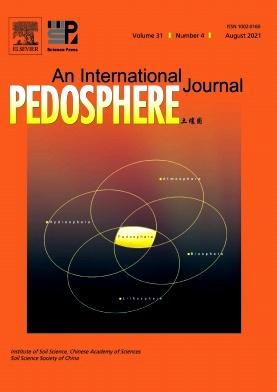Effects of metal oxide nanoparticles on soil water retention curve and tensile strength
IF 5.2
2区 农林科学
Q1 SOIL SCIENCE
引用次数: 0
Abstract
Generally, nanotechnology plays an very important role in various applied scientific fields. Iron and magnesium nanoparticles (NPs) can cause positive or negative changes in soil physical and mechanical properties, especially in long periods. The aim of this study was to investigate the multi-year effects of NPs on soil water retention and aggregate tensile strength. A wheat farm loamy soil was amended with 1%, 3%, and 5% (weight/weight) of magnesium oxide (MgO) and iron oxide (Fe3O4) NPs in three replications and incubated for three years. Water contents were measured at different matric suctions of 0, 10, 20, 40, 60, 100, 300, 1 000, and 15 000 cm. The van Genuchten model was fitted to the moisture data. Tensile strength was measured on the 2–4 mm aggregates at matric suctions of 300 (i.e., field capacity) and 15 000 (i.e., permanent wilting point) cm. The results showed that the levels of 1% and 3% Fe3O4 NPs significantly increased water retention, compared to the no NP application control and 5% MgO NPs, which is probably due to the increase of adsorption surfaces in the treated soils. Water contents at field capacity and permanent wilting point in the 5% MgO NP treatment decreased compared to those of the other treatments, due to the increased soil vulnerability and reduced soil fine pores. The application of Fe3O4 NPs did not have any significant effect on soil tensile strength. Based on the results of this study, soil physical and mechanical properties could be affected by NP application.
氧化物纳米粒子对土壤保水曲线和土壤抗拉强度的影响
总的来说,纳米技术在各个应用科学领域发挥着非常重要的作用。铁和镁纳米颗粒(NPs)可以引起土壤物理和机械特性的积极或消极变化,特别是在很长一段时间内。本研究的目的是研究NPs对土壤保水性和骨料抗拉强度的多年影响。在小麦农场壤土中分别添加1%、3%和5%(重量/重量)氧化镁(MgO)和氧化铁(Fe3O4) NPs 3个重复,孵育3年。在0、10、20、40、60、100、300、1 000和15 000 cm不同的基质吸力下测定含水量。将van Genuchten模型与湿度数据拟合。在基质吸力为300(即现场容量)和15 000(即永久萎蔫点)cm时,测量2-4 mm骨料的抗拉强度。结果表明,与不施用NP和5% MgO NPs相比,施用1%和3% Fe3O4 NPs显著提高了土壤的保水能力,这可能是由于处理后土壤的吸附面增加所致。与其他处理相比,5% MgO NP处理的田间容量含水量和永久萎蔫点降低,这是由于土壤脆弱性增加和土壤细孔减少所致。施用Fe3O4 NPs对土壤抗拉强度无显著影响。基于本研究结果,NP的施用会影响土壤的物理力学性质。
本文章由计算机程序翻译,如有差异,请以英文原文为准。
求助全文
约1分钟内获得全文
求助全文
来源期刊

Pedosphere
环境科学-土壤科学
CiteScore
11.70
自引率
1.80%
发文量
147
审稿时长
5.0 months
期刊介绍:
PEDOSPHERE—a peer-reviewed international journal published bimonthly in English—welcomes submissions from scientists around the world under a broad scope of topics relevant to timely, high quality original research findings, especially up-to-date achievements and advances in the entire field of soil science studies dealing with environmental science, ecology, agriculture, bioscience, geoscience, forestry, etc. It publishes mainly original research articles as well as some reviews, mini reviews, short communications and special issues.
 求助内容:
求助内容: 应助结果提醒方式:
应助结果提醒方式:


